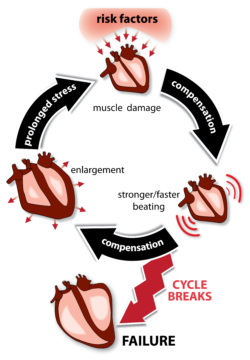Although it’s been years, I still remember my shocked first sight of an end-stage failing heart. On my way out of the operating room, I called a friend and blurted, ”It looked like a wet plastic bag, barely contracting! How could this possibly happen?”
Heart failure is a deadly condition in which the heart muscle is weakened and can’t meet body’s demand for oxygen. Although scientists can’t fully answer the question of how it happens, they are able to recognize several risk factors that make heart failure more likely. You are probably aware of them: smoking, overeating, consuming too much alcohol, and getting too little exercise—basically, the things your mom taught you are bad for your health.

But if the person doesn’t change his or her unhealthy habits, the heart will continue to be injured and need to compensate more and more until finally, it fails. The saddest part of this scenario is that it’s preventable.
When I drew this diagram, I was struck by the parallels between heart function and personal relationships, how often we get stuck in cycles and ignore where they are taking us (see the figure). For example, how often have you heard someone complain that a partner works too much? The longer the working hours, the more complaining—and typically, the response to complaining is working more hours. Not realizing that they have created a cycle, partners compensate by mutual fault-finding. As they engage in a “blame ping-pong match,” they strengthen and reinforce each destructive element of the cycle. The injured relationship may continue, but as trust and intimacy erode, the relationship may fail completely.
It would be fabulous if a little alarm clock could warn us when we approach the last lap of the cycle. But why wait until the last lap? Whatever cycle you’re currently in, step off the track a moment to foresee where the cycle is headed. Where might you find an exit? Draw it on a piece of paper. Even if you sense that you are deeply entrenched in happiness-killing habits, try not to feel hopeless. Embrace the chance you have today to resolve problems. Ask yourself, What would I do differently today, if I knew I was entering the last lap before the relationship fails entirely?
Amazing things can happen when you deliberately break a negative cycle. You may not only improve some of the most important areas of your life, but also gain a whole new level of awareness of how much something means to you. You’ll become more grateful for what you already have. Finding yourself stuck in a cycle does not automatically mean disaster—just don’t delay breaking the cycle.
Tick tock. The time is now!
